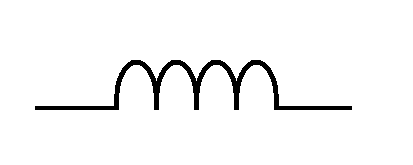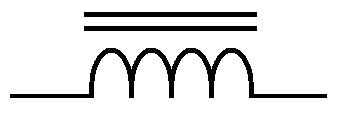| Vocademy |
Inductors

| Various low value inductors. The left one has a ferrite [1] core. The middle ones are wound on “doughnuts” made of ferrite. These are called toroidal inductors. The right one is encased in plastic and it probably also has a ferrite core. |
Schematic symbols
 |
 |
 |
| Air Core | Iron Core | Ferrite Core |
As mentioned previously, in 1830 Hans Christian Oersted
demonstrated that when a current passes through a wire that there is a
magnetic field around that wire. Joseph Henry and Michael Faraday took Oersted's discovery to the next step and independently discovered the
properties of induction. Simply stated, when you pass an electric
current through a wire you generate a magnetic field. When you pass a
wire through a magnetic field (or pass a magnetic field over a wire)
you generate an electric current. Here's a video that makes an
interesting demonstration of this:
World's First Electric Generator
Notice that nothing happens when
nothing is moving. No current, no magnetic field. Stationary wire in a
stationary magnetic field, no current. Only when the electrons are
moving in the wire do we get a magnetic field. Likewise, only when the
wire is moving through the magnetic field or the magnetic field is
moving past the wire do we get a current.
When we wrap the wire in loops it concentrates the magnetic field. A soft iron[2] core amplifies the field[3]. This makes and electromagnet—a magnet that you can turn on and off with a switch. That's easy enough: switch on you have a magnet; switch off, no more magnet. However, interesting things happen between the time the switch is turned on and the time the magnetic field is fully developed. While the magnetic field is building, that magnetic field is passing the very coils of wire that are creating the field. Let's take a second look at that. Current through the coils creates a magnetic field. The building magnetic field moves through the coils of wire. That moving magnetic field induces another current in the very coils that are producing the magnetic field. That current flows against the current that is creating the field. Let's take a third look at that. Push a current into a coil and it creates a magnetic field. That magnetic field creates another current that pushes right back. So when you push a current into a coil it says, “oh no you don't” and blocks that current. The reverse current causes a corresponding voltage called “back EMF”.
This back EMF is only produced while the magnetic field is building. Once the magnetic field is as large as the current can make it, there is no more back EMF. The coil is no longer pushing back on the current, which flows as freely as it would in any wire. Let's take a fourth look at it. When you push a current into a coil, the coil blocks the current. As time passes more and more current flows until eventually it flows freely.
What happens when you try to stop the current? The magnetic field collapses. Now the field is passing the coils of wire in the opposite direction. This induces a current in the same direction that the current is already flowing. It tries to keep the current moving. As time passes the collapsing magnetic field is able to induce less and less current until it is finally gone and no more current flows.
In review, it is hard to push a current into a coil at first, but once the current is flowing, it is hard to stop the flow.
The rules for electromagnetic induction are:
Bottom line: an inductor resists changes in current but doesn't resist a steady current. This property is called self-induction.
When we wrap the wire in loops it concentrates the magnetic field. A soft iron[2] core amplifies the field[3]. This makes and electromagnet—a magnet that you can turn on and off with a switch. That's easy enough: switch on you have a magnet; switch off, no more magnet. However, interesting things happen between the time the switch is turned on and the time the magnetic field is fully developed. While the magnetic field is building, that magnetic field is passing the very coils of wire that are creating the field. Let's take a second look at that. Current through the coils creates a magnetic field. The building magnetic field moves through the coils of wire. That moving magnetic field induces another current in the very coils that are producing the magnetic field. That current flows against the current that is creating the field. Let's take a third look at that. Push a current into a coil and it creates a magnetic field. That magnetic field creates another current that pushes right back. So when you push a current into a coil it says, “oh no you don't” and blocks that current. The reverse current causes a corresponding voltage called “back EMF”.
This back EMF is only produced while the magnetic field is building. Once the magnetic field is as large as the current can make it, there is no more back EMF. The coil is no longer pushing back on the current, which flows as freely as it would in any wire. Let's take a fourth look at it. When you push a current into a coil, the coil blocks the current. As time passes more and more current flows until eventually it flows freely.
What happens when you try to stop the current? The magnetic field collapses. Now the field is passing the coils of wire in the opposite direction. This induces a current in the same direction that the current is already flowing. It tries to keep the current moving. As time passes the collapsing magnetic field is able to induce less and less current until it is finally gone and no more current flows.
In review, it is hard to push a current into a coil at first, but once the current is flowing, it is hard to stop the flow.
The rules for electromagnetic induction are:
- Whenever you have a wire pass through a stationary magnetic field an electric current is produced in that wire.
- Whenever you move a magnetic field past a stationary wire an electric current is produced in that wire.
- The electric current is only produced when there is movement between the wire and magnetic field. If there is no motion, no electric current or magnetic field is produced.
- When you push current into an inductor the coil pushes back at first but then allows the current to flow freely
- When you try to stop the current in an inductor it tries to keep the current flowing but eventually runs out of energy and the current stops.
Bottom line: an inductor resists changes in current but doesn't resist a steady current. This property is called self-induction.
Inductors Part 1 - Introduction to Inductors
How Iron Increases Inductance
—————————
| Vocademy |